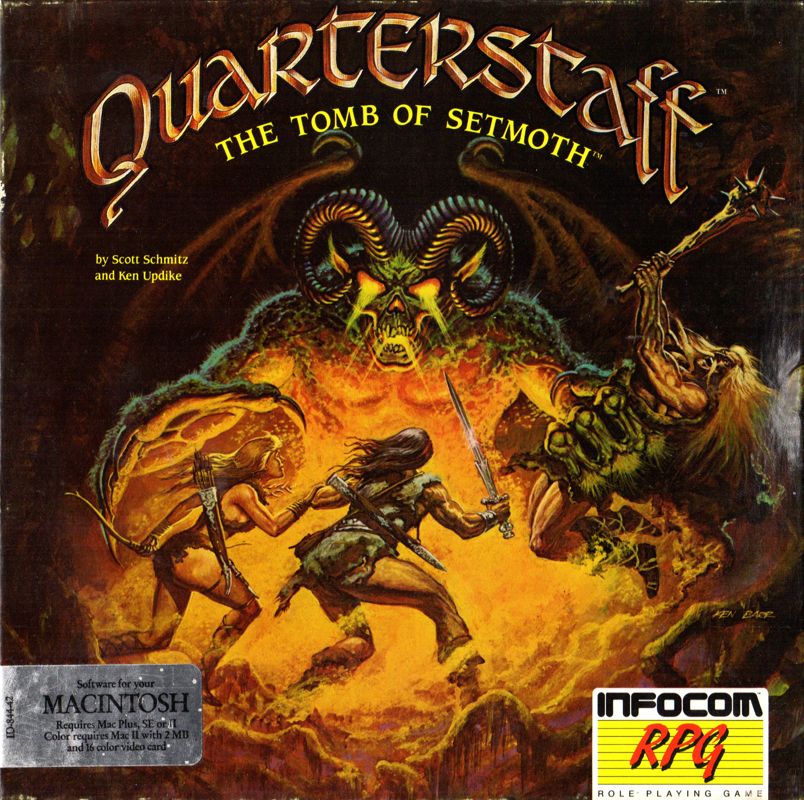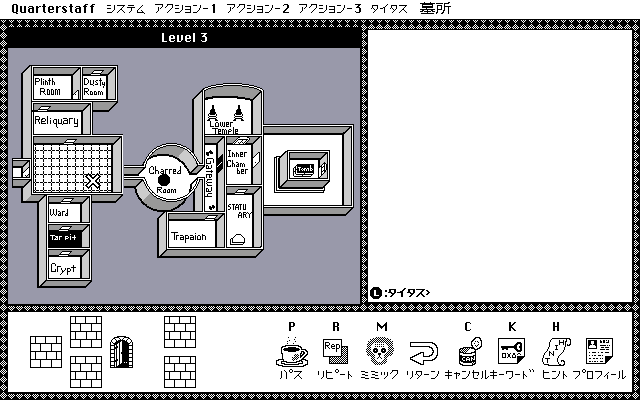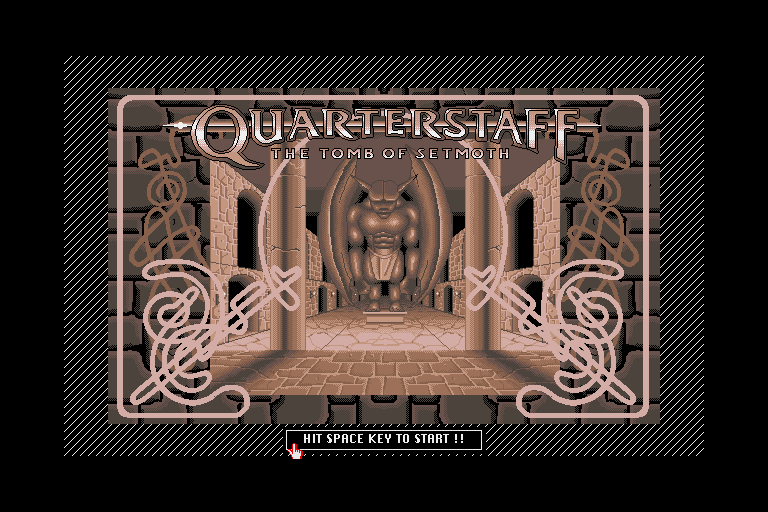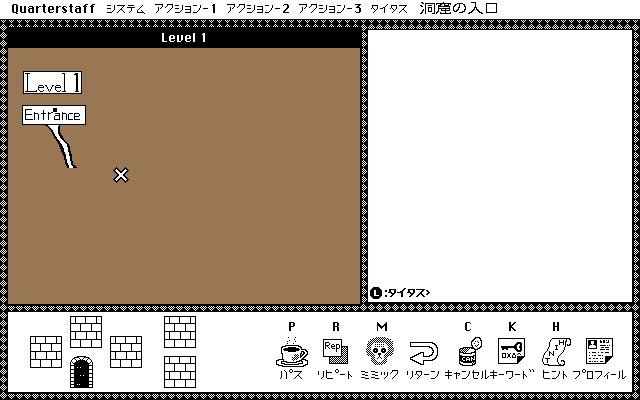Retro Replay Review
Gameplay
Quarterstaff: The Tomb of Setmoth introduces players to a hybrid of text-driven adventure and early graphical RPG, blending Infocom’s signature interactive prose with point-and-click mechanics. From the outset, character creation involves a surprisingly deep selection of attributes, skills, and party members, setting the stage for engaging strategic decisions. Your party’s composition—whether you favor brute strength, arcane knowledge, or a balanced troupe—directly influences dialogue options, combat approaches, and puzzle solutions.
Infocom’s addition of a Help window and hint system marks a welcome evolution from the original Mac release. Rather than interrupt the narrative flow, hints are concealed behind a contextual sidebar that can be revealed at the player’s discretion. This handy gadget ensures that newcomers won’t become irreparably stuck, while veterans can challenge themselves to resist temptation and solve the game’s toughest riddles without assistance.
Combat encounters in Quarterstaff walk the line between turn-based strategy and real-time tension. You issue commands to each party member—attack, defend, cast spells, or use items—and watch as the action unfolds on the screen. Though combat can feel slower compared to modern RPGs, the deliberate pace allows for thoughtful positioning and resource management, making each victory satisfying and each defeat a prompt to rethink tactics.
Puzzle design remains rooted in Infocom’s heritage of logical problem-solving. From deciphering ancient runes to rerouting mystical energy flows, the Tomb of Setmoth is filled with cerebral challenges. Many puzzles have multiple solutions, encouraging exploration and creativity. Collaboration between party members also plays a crucial role, as certain skills or spells only become available when the right character is in your active roster.
Graphics
Visually, Quarterstaff is a testament to early color Macintosh capabilities. Infocom’s development team applied a fresh coat of paint to the black-and-white original, adding vivid hues to cavern walls, glowing runestones, and the various monsters lurking in the dungeon depths. Although the resolution is modest by today’s standards, the hand-drawn feel of each sprite and background asset lends the game a charming, almost storybook quality.
The user interface benefits from thoughtful layout and ease of use. Action buttons, inventory slots, and the Help window are arranged logically around the main display, minimizing clutter while keeping important information in view. Tooltips and color-coded status bars further enhance clarity, letting you know at a glance which party members are healthy, fatigued, or affected by magical conditions.
Animations are limited but effective—spells shimmer with animated particles, doors creak open with a subtle frame swap, and combat sequences display brief but evocative attack motions. These touches, while simple, breathe life into what might otherwise have been a static dungeon crawl. The vivid coloration of magical effects helps distinguish elemental spells from mundane attacks, giving combat a visually rewarding flair.
Environmental design leans on moody palettes and sharp contrasts. Dark corridors are awash with deep purples and blues, while treasure rooms glimmer in golds and reds. Infocom’s color choices not only improve the original visuals but also heighten the sense of place, making exploration feel atmospheric rather than repetitive.
Story
The narrative arc of The Tomb of Setmoth revolves around an ancient evil entombed in a remote desert temple. Infocom’s revisions to the original Simulated Environment Systems storyline add new lore, deeper character motivations, and a more intricate web of side quests. Cutscenes—delivered through richly descriptive text—set up the central conflict: the resurrection of the nefarious Setmoth and the race to secure relics that can stop him.
Character interactions are a strong point of the game’s writing. Dialogue options adjust based on your party’s composition, and certain NPCs will respond differently if you send in a warrior versus a wizard. These dynamic exchanges enrich the narrative and encourage multiple playthroughs, as different party builds unlock unique story beats or quest paths.
Pacing is well-balanced, with periods of dungeon exploration interspersed with narrative interludes at the town hub. Here, you can rest, trade, and gather rumors that hint at hidden secrets in the tomb. These breaks in the action provide context for your quest and introduce supporting characters whose fates intertwine with the main storyline, lending emotional weight to your choices in the field.
Infocom’s reputation for polished prose shines through in the flavor text describing ancient inscriptions, monster lore, and environmental details. The team’s editorial polish on the original manuscript ensured that the voice remains consistent—mixing dry humor, epic stakes, and occasional foreshadowing to keep players invested until the climactic confrontation.
Overall Experience
Quarterstaff: The Tomb of Setmoth stands as a compelling artifact of early RPG design, elevated by Infocom’s storytelling prowess and quality-of-life enhancements. Its hybrid interface, melding text adventure roots with graphical elements, may feel quaint to modern gamers but remains remarkably accessible and engaging. The added help system bridges the difficulty curve, making this title approachable for both RPG newcomers and genre veterans.
Players who appreciate methodical exploration and puzzle-driven progression will find much to enjoy here. While combat can sometimes slow the pace, the strategic depth and party customization options provide enough variety to keep encounters fresh. Likewise, the color palette and UI refinements demonstrate Infocom’s commitment to making the Mac experience truly pop.
The Tomb of Setmoth’s narrative, enriched by additional lore and character dynamics, rewards attentive players with satisfying twists and memorable NPCs. The game’s world is rendered in both text and visuals with care, ensuring that each corridor, ruin, and chamber feels part of a cohesive whole. For those seeking an adventure that blends cerebral puzzles, legacy text flair, and early graphical charm, Quarterstaff delivers a uniquely rewarding journey.
Ultimately, this Infocom release is more than a historical curiosity—it’s a timeless example of creative adaptation and iterative design. Whether you’re exploring its depths for the first time or revisiting an old favorite, The Tomb of Setmoth offers a rich, if occasionally old-school, RPG experience that still resonates today.
 Retro Replay Retro Replay gaming reviews, news, emulation, geek stuff and more!
Retro Replay Retro Replay gaming reviews, news, emulation, geek stuff and more!









Reviews
There are no reviews yet.